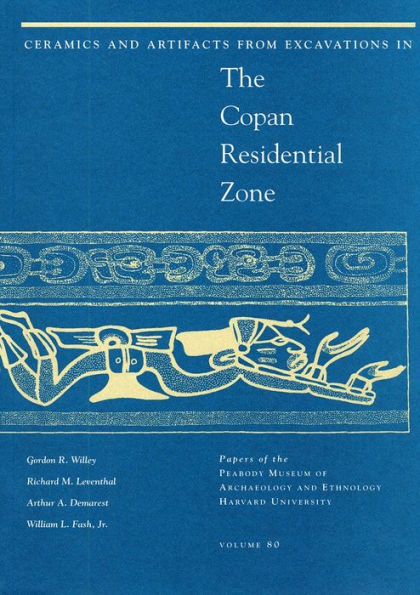Table of Contents
Preface
Acknowledgments
1. Introduction
BACKGROUND TO COPAN ARCHAEOLOGICAL INVESTIGATIONS
BRIEF DESCRIPTION OF THE HARVARD COPAN PROJECT
RESEARCH OBJECTIVES
FIELD AND LABORATORY PROCEDURES
2. Ceramics
PRECLASSIC/PROTOCLASSIC PHASES
The Uir Phase
The Chabij Phase
Pacheco Zoned Bichrome Type
Okla Brown Type
Bozo Incised Type
The Bijac Phase
Povmec Red-on-orange Type
Moscova Red Type
EARLY CLASSIC PHASE
The Acbi Phase
Izalco Usulutan Type
Cementerio Incised Type: Zigoto Variety
Hijole Unslipped Type
Prospero Red-on-buff Type
Chitam Red-on-cream Type
Adan Red-on-buff Type
Ricardo Composite Type
Burdalu Red Type
Melano Carved Type
Melachrino Brown Type
Con Permiso Red-on-brown Type
LATE CLASSIC PHASES
The Cueva Phase
Chilanga Red-painted Usulutan Type
Arturo Incised Type
Cara Gorda Composite Type
Capulin Cream Type
Champona Incised Type
Sombra Resist Type
Mapache Grooved Type
Cementerio Incised Type
Arroyo Red Type
Sopi Incised Type
Antonio Buff Type
Switch Molina Striated Type
Chalja Red-painted Type
Molanphy Modeled-carved Type
Chalja Incised Type
Gualpopa Polychrome Type
The Coner Phase
Ardilla Gouged-incised Type: Ardilla and Crapo Varieties
Reina Incised Type
Tipon Orange-brown Type
Don Gordon Modeled-carved Type
Claudio Incised Type
Tasu Fluted Type
Copador Polychrome Type: Glyphic Varieties A-E
Copador Polychrome Type: Geometric Variety
Doric Composite Type
Caterpillar Polychrome Type
Babilonia Polychrome Type
Masica Incised Type
Raul Red Type: Raul and Unspecified Varieties
Casaca Striated Type: Casaca Variety
Casaca Striated Type: Crud Variety
Lorenzo Red Type
Sepultura Unslipped Type
Residual Types
Lysandro Unslipped Type
COMPARATIVE PERSPECTIVES ON CERAMICS: A SUMMARY
3. Other Artifacts
POTTERY FIGURINES AND FIGURINE WHISTLES
General, Comparative, and Summary Comments
Preclassic-Early Classic (?) Figurines (?)
Large, Solid Figurine Body Fragments
Late Classic Figurines and Figurine-whistles
Animals or Birds
Maya Men: Elaborately Attired
Maya Warriors
Maya Women
Monsters
Semi-solid, Simply Dressed Type
Semi-solid, Simply Dressed Type: Crude
Human Figurine Fragments
Human or Animal Figurine Fragments
Large Human Figurines
MISCELLANEOUS POTTERY OBJECTS
General, Comparative, and Summary Comments
Unperforated Potsherd Disks
Perforated Potsherd Disks (Spindle Whorls)
Other Worked Potsherds
Spindle Whorls (Specially Manufactured)
Potsherd Pendants
Beads
Ear Ornaments
Ceramic Ornaments or Ritual Objects
Seals or Stamps
Collanders
Candeleros
Cylindrical
Bottle-shaped
Conical
Rectangular
Multi-chambered
Miscellaneous Forms
Miniature Vessels
Briquette Material
GROUND STONE
General, Comparative, and Summary Comments—with Assistance from Julia A. Hendon
Metates—with Assistance from Julia A. Hendon
Type 1
Type 2
Type 3
Type 4
Special
Manos—with Assistance from Julia A. Hendon
Small Round
Large Round
Square
Triangular
Pentagonal
Overhang
Plano-convex
Thin Ovate-rectangular
Thick Ovate-rectangular
Mortars or Grinding Slabs
Type 1
Type 2
Barkbeaters
Rubbing and Pounding Stones
Rubbing Stones
Pounders
Spherical or Egg-shaped Stones
Polishing Stones and Polished Pebbles
Pestle
Anvil Stones
Drill Braces
Weight or Anchor
Celts
Large Variety
Medium Variety
Small Variety
Very Small Variety
Alabaster Vessel
Ring Stones
Rectangular Perforated Stones
Mirrors
Ear Ornaments (Jadeite)
Pendants (Jadeite)
Adornos (Jadeite)
Beads (Jadeite)
Flat-rectanguloid Variety
Irregular Variety
Barrel-shaped Variety
Disk Variety
Large Tubular Variety
Small Tubular Variety
Subspherical Variety
Miscellaneous Pebbles (Jadeite)
Raw Jadeite
Ornaments (Not Jadeite)
Stone Figurine
Stone Yoke (?)
Celt-like Objects or Ritual Maces
Star-shaped Stone
Stone Disks
Incised Stones
Stone Tables
Concretions, Geodes, and Minerals
Miscellaneous Worked Stone Fragments
Angle Stones or Architectural Stones
MINOR SCULPTURES
General, Comparative, and Summary Comments
Architecturally Attached Sculptures
Freestanding Sculptures
CHIPPED STONE (FLINT)
General, Comparative, and Summary Comments
Projectile Points or Knives
Straight Stem, Long Blade
Laurel-leaf Blades
Scrapers
Drills
Bifacial
Unifacial
Pebble Choppers or Pounders
Eccentrics
Scrap
Chert Debitage: Detailed Descriptions and Comments—Daniel R. Potter and Fred Valdez
Raw Material
Classification Analysis
Copan Debitage
Recycling
Summary
CHIPPED STONE (OBSIDIAN)—FRED VALDEZ
Analysis: Methodology and Presentation
The Harvard Copan Project Collection
Typological, Technological, and Use-Wear Descriptions
Wastage
Unifacial Artifacts
Bifacial Artifacts
The Copan Obsidian Assemblage and Use-Wear Comments
BONE ARTIFACTS
General, Comparative, and Summary Comments
Whistle
Effigy
Tubes
Awls
Pins
Animal Teeth
Antler Tine
Turtle Shell Spines (?)
SHELL ARTIFACTS, SHELLS, AND MARINE MATERIALS
General, Comparative, and Summary Comments
Pendants
Adornos
Tinkler
Beads
Rectangular Cut Pieces
Spondylus sp. Shells
Pachychilus corvinus Shells
Pachychilus largillierti Shells
Other Shells
Crab Claw
Stingray Spines
Coral Sections
Marine Worm Tubes
COMPARATIVE PERSPECTIVES ON OTHER ARTIFACTS: A SUMMARY
A SUMMARY OF INTRASITE DISTRIBUTIONS AND THEIR IMPLICATIONS
Figurines
Drifts and Scrapers—Chert and Obsidian
Projectile Points and Chert Artifacts
Polishing, Pounding, and Rubbing Stones
Celts
Mortars
Manos
Metates
Obsidian
Other Artifact Types
Candeleros
4. Statistical Analyses and Interpretations—with Assistance from Kevin Baxter and Mary Bane Stevens
The Data
Correlation
Correlation Interpretation
Structure Function
Copan Valley Excavations
Data Analysis
Clustering Techniques
Discriminant Analysis
Interpretations
5. General Summary and Conclusions
Bibliography
APPENDIX A. Whole Vessels and Special Find Proveniences
APPENDIX B. Chemical Compositional Analysis of Southeastern Maya Ceramics—Ronald L. Bishop and Marilyn P. Beaudry
APPENDIX C. The Sources of Copan Valley Obsidian—Garman Harbottle, Hector Neff, and Ronald L. Bishop
APPENDIX D. Late Classic Maya Fauna from Settlement in the Copan Valley, Honduras: Assertion of Social Status Through Animal Consumption—Mary D. Pohl
APPENDIX E. The Mollusks of Copan—Lawrence H. Feldman



